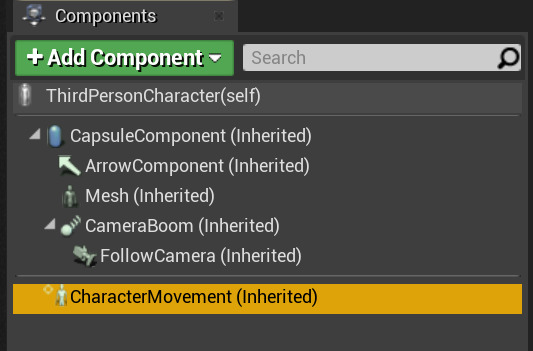
<aside> 💡 Prerequisite Topics In order to understand and use the content on this page, make sure you are familiar with the following topics:
The character movement component is an Actor Component that provides an encapsulated movement system with common modes of movement for humanoid characters, including walking, falling, swimming, and flying. The character movement component also features robust network gameplay integration. Its default movement modes are all built to replicate by default, and it provides a framework to help developers create custom networked movement.
UCharacterMovementComponent comes preattached to the ACharacter Actor class and any Blueprints derived from it.

During its TickComponent function, UCharacterMovementComponent will call PerformMovement to calculate desired acceleration within the world based on what movement mode it is currently using as well as the player's input variables, commonly represented with the control input variables in APlayerController . Once movement calculations are finalized, UCharacterMovementComponent applies the final movement to the owning character.
<aside>
💡 While ACharacter is derived from APawn, Characters are not simply Pawns that have a character movement component added to them. UCharacterMovementComponent and ACharacter are designed to be used together, as ACharacter overrides several replicated variables and functions specifically to facilitate replication in UCharacterMovementComponent.
</aside>
The PerformMovement function is responsible for physically moving the character in the game's world. In a non-networked game, UCharacterMovementComponent calls PerformMovement directly each tick. In a network game, PerformMovement is called by specialized functions for servers and clients to either perform the initial movement on a player's local machine or reproduce that movement on remote machines.
PerformMovement handles the following:
StartNewPhysics, which selects a Phys* function based on what movement mode the character is using.Each movement mode has its own Phys* function that is responsible for calculating velocity and acceleration. For example, PhysWalking determines the character's movement physics when moving on the ground, while PhysFalling determines how it behaves in the air. If you wanted to debug the specifics of these behaviors, you would look inside each of these functions.
If a movement mode changes during a tick, such as when a character starts falling or collides with an object, the Phys* functions call StartNewPhysics again to continue the character's motion in the new movement mode. StartNewPhysics and the Phys* functions each pass through the number of iterations of StartNewPhysics that have occurred. The parameter MaxSimulationIterations is the maximum number of times this recursion is allowed.
UCharacterMovementComponent uses its owner's network role to determine how to replicate movement. The three network roles are as follows:
| Network Role | Description |
|---|---|
| Autonomous Proxy | The character is on its owning client's machine, being controlled locally by a player. |
| Authority | The character exists on the server hosting the game. |
| Simulated Proxy | The character exists on any other client that can see the remotely-controlled character, whether it's being controlled by an AI on the server or by an autonomous proxy on a different client. |
The replication process follows a cycle within the TickComponent function, which repeats itself on every tick. As the character performs movement, copies of it on all the different machines in the network game make Remote Procedure Calls (RPCs) to each other to synchronize movement information, with different network roles using different execution paths as appropriate.
The table below provides a step-by-step overview of what UCharacterMovementComponent does on each machine during this process: